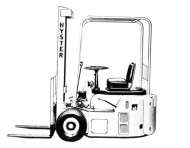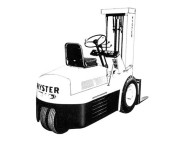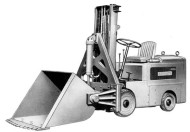 Warehouse & Logistics News is proud to bring you the forty-sixth instalment in our exclusive series on the history of the fork lift truck, the machine that over the decades has revolutionised the face of materials handling around the world.
Warehouse & Logistics News is proud to bring you the forty-sixth instalment in our exclusive series on the history of the fork lift truck, the machine that over the decades has revolutionised the face of materials handling around the world.
Our writer is James Brindley, an acknowledged authority on fork lift trucks. James’s distinguished career has involved engineering and management roles with BT Rolatruc and serving as a Director of the Fork Lift Truck Association, before he set up the National Fork Truck Heritage Centre in 2004 as Britain’s first such collection open to the public.
The Heritage Centre continues to need your support in 2010, and if you or your company would like to help in any way, you can contact James on the number below. Now sit back and enjoy the latest part of this fascinating series.
Episode 46: 1964: LPG gaining ground as fork lift fuel
In the wake of 1964’s Earls Court exhibition, which stands as one of the finest ever shows at that venue ever came news of a revolutionary fuel, which was rapidly gaining popularity with most of the large manufacturers and customers alike. These days most of us in the fork truck industry take for granted the use of LPG (liquid petroleum gas) as an alternative to power a fork lift truck, but in the early sixties it was still a rare choice. Precise dates for the first use of LPG in British manufactured forklifts are not available, but in America there is evidence that the Hyster Company was advertising the option on their model QN 20, which was fitted with the Wisconsin, 4 cylinder-V type engines. This forklift truck was in production from 1949 to 1956.
 LPG is a gaseous by-product of oil refining and is known in two main forms, propane and butane. Both of these gases liquefy under pressure and are stored as a liquid, vaporising when pressure is released. Propane, which is stored at higher pressures, becomes gaseous at very low temperatures (down to -20 degrees centigrade) and has a much higher rate of vaporisation. Because of the higher pressures involved this gas must be stored in a higher grade of pressure vessel. This is the preferred fuel for nearly all LPG fork lifts and is ideal for most outdoor applications. Butane however, due to its lower rate of vaporisation and consequential lower working pressure, can be stored quite safely in lower pressure vessels designed for this task. This fuel is ideal for indoor home heating and lighting and for powering many types of domestic appliance.
LPG is a gaseous by-product of oil refining and is known in two main forms, propane and butane. Both of these gases liquefy under pressure and are stored as a liquid, vaporising when pressure is released. Propane, which is stored at higher pressures, becomes gaseous at very low temperatures (down to -20 degrees centigrade) and has a much higher rate of vaporisation. Because of the higher pressures involved this gas must be stored in a higher grade of pressure vessel. This is the preferred fuel for nearly all LPG fork lifts and is ideal for most outdoor applications. Butane however, due to its lower rate of vaporisation and consequential lower working pressure, can be stored quite safely in lower pressure vessels designed for this task. This fuel is ideal for indoor home heating and lighting and for powering many types of domestic appliance.
When LPG is used as a fuel in the internal combustion engine it enters the system as a dry gas, and as such combines readily with air to form an ideal combustible mixture. In this condition the mixture vaporises completely under most conditions, including cold weather starting, ensuring that the engine operates at maximum efficiency almost immediately. The complete combustion of the mixture also results in a substantial reduction in running costs and the virtual elimination of obnoxious fumes and particulates in the exhaust gases. It also prevents the formation of carbon deposits and the dilution and contamination of the engine lubricating oil, giving a vast reduction in engine wear.
 The initial promoter of LPG’s adoption into British industry was Fred Myers Ltd., the dealer for Hyster fork lift trucks during 1956. This was the year when model numbers UE30, YE40 and HE50 were launched and fitted with the American Continental engines. These were designed for running on LPG and were supplied to companies such as Ford Motors at Dagenham, Unilever Ltd and Carlsberg Distributors Ltd.
The initial promoter of LPG’s adoption into British industry was Fred Myers Ltd., the dealer for Hyster fork lift trucks during 1956. This was the year when model numbers UE30, YE40 and HE50 were launched and fitted with the American Continental engines. These were designed for running on LPG and were supplied to companies such as Ford Motors at Dagenham, Unilever Ltd and Carlsberg Distributors Ltd.
During 1958 investigations were made into the performance of a Stacatruc 2 PHA that had been fitted with an Austin A 70 engine and modified with a Lipton gas conversion kit. The results after 2,445 hours of running showed that the oil was still reasonably clean, and entirely free from dilution. During this time no maintenance had been carried out apart from lubricating oil, which worked out at 0.015 pints an hour. It was confirmed by examination that no discernable engine wear had taken place.
The main suppliers of gas for fork lifts in Britain for the years mentioned were Calor Gas (Distributing) Co Ltd, who did valuable work in promoting and pioneering the use of LPG in fork lift trucks and Shell-Mex and B. P. Gases Ltd, who distributed their product under the banners of ‘Propagas’ and ‘Bottogas’.
To be continued
By James Brindley, Director, National Fork Truck Heritage Centre.
If you would like to support the National Fork Truck Heritage Centre, please call James Brindley on 0780 195 4167




Comments are closed.